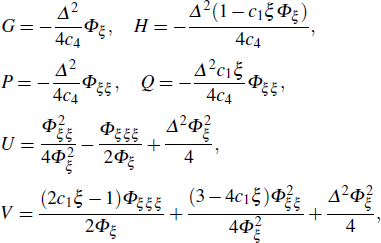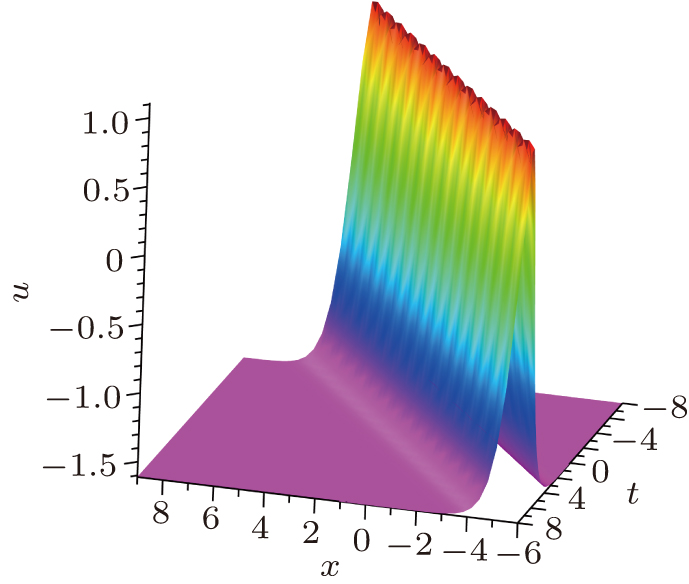1. IntroductionThe well-known KdV equation is one of the most important integrable systems in the soliton theory and has been studied extensively since it is proposed to describe the shallow water wave propagation with small but finite amplitudes.[1] The classical Lie symmetry and nonclassical Lie symmetry methods are very effective to find the exact solutions of a given nonlinear system. But these classical symmetry methods can only involve the independent, dependent variables and their derivatives.[2] In order to find much more interaction solutions among solitons and other complicated wave solutions for the nonlinear systems, many authors proposed the nonlocal symmetry by the Bäcklund transformation, the Möbius invariant form, the Painlevé truncation expansion, and the Darboux transformation. Many new interaction solutions among different types of nonlinear excitations including the solitons, cnoidal waves, Airy waves, and Bessel waves for a number of integrable systems, such as the Kadomtsev–Petviashvili equation, the Burgers equation, the modified Kadomtsev–Petviashvili equation, and the coupled integrable dispersionless equation, are constructed by means of the nonlocal symmetry.[3–19] We should point out that these new interaction excitations have not been yet obtained by other traditional methods, such as the inverse scattering transformation, the Hirota bilinear method, and the separation variable approach.
Recently, many integrable negative-order nonlinear systems have been studied in the field of soliton theory and some relevant branches of physical phenomena.[20–22] The author proposed and constructed the exact solutions of a special integrable equation combining the well-known KdV equation and the negative-order KdV (KdV–nKdV) equation in Ref. [23]. The KdV–nKdV equation is given in the form


where
u =
u(
x,
t) and
v =
v(
x,
t). The author aimed to obtain a sequence of equations of increasing negative orders by the negative order recursion operators based on the results of Olver.
[24,25] Wazwaz derived the multiple soliton solutions and periodic solutions for the KdV–nKdV equations (
1) and (
2) by the Hirota bilinear form and showed that it is integrable in the sense of admitting the Painlevé property. The
N-th Bäcklund transformation and soliton-cnoidal wave interaction solutions for the KdV–nKdV equation has been studied in Ref. [
26].
In this paper, we focus on the nonlocal symmetry and similarity reduction equation for the integrable KdV–nKdV equation by the Painlevé truncation method and the classical Lie symmetry method. The nonlocal symmetry for the KdV–nKdV equations (1) and (2) is localized to Lie point symmetry by introducing four dependent variables. The finite symmetry transformations related to the nonlocal symmetry are obtained for the enlarged system.
This paper is organized as follows. In Section 2, the nonlocal symmetries related to the truncated Painlevé expansion are obtained and the corresponding finite transformation is derived by solving the initial value problem of the enlarged system. In Section 3, the different symmetry reductions for the enlarged system are studied according to the Lie point symmetry method. Summary and discussion are given in the last section.
2. Nonlocal symmetries and their localization for the KdV–nKdV equations (1) and (2)In this section, we give the nonlocal symmetry and corresponding finite symmetry transformation for the KdV–nKdV equations (1) and (2). Based on the truncated Painlevé analysis of the KdV–nKdV equation, the Laurent series form reads


where
ϕ =
ϕ(
x,
t) is an arbitrary singularity manifold and the functions {
u0,
u1,
u2,
v0,
v1,
v2} are functions to be determined later. Substituting the expansion (
4) into Eqs. (
1) and (
2) and vanishing all the coefficients of different powers of
ϕ=
=(
x,
t) independently, we have




where

is the usual Schwarzian variable. We can find that the residual {
u1,
v1} are the nonlocal symmetry corresponding to the solutions {
u2,
v2} based on the definition of residual symmetry.
[27] The expression of Eqs. (
3) and (
4) is just an auto-Bäcklund transformation between the solutions {
u2,
v2} and {
u,
v} if the function
ϕ satisfies the consistent condition (
8). Then the nonlocal symmetry of Eqs. (
1) and (
2) can be read out directly from the truncated Painlevé expansion of Eqs. (
3) and (
3) with Eq. (
5)

and the corresponding initial value problem of Eq. (
9) is

with
ε being an infinitesimal parameter. It is difficult to solve the initial value problem of the Lie’s first principle due to the intrusion of the arbitrary function
ϕ and its derivatives. In order to solve the initial value problem (
10), we can introduce four dependent variables by requiring

It is not difficult to find that the solution of the linearized equations of Eqs. (
1), (
2), (
6), (
7), and (
11) has the form

and the corresponding initial value problem becomes

The solution of the initial value problem Eq. (
13) for the enlarged system of Eqs. (
1), (
2), (
6), (
7), and (
11) can be written as

Using the finite symmetry transformation, one can obtain solitary wave solution for Eqs. (
1) and (
2) with the trivial solution
u2 =
v2 = 0. If selecting the nontrivial seed solution and different types of the function
ϕ in Eq. (
8), one can obtain much more exact solutions of Eqs. (
1) and (
2).
3. Similarity reduction related to the nonlocal symmetry (9)The nonlocal symmetry for the KdV–nKdV equation cannot be used to construct explicit solution directly because of the difficulty to find the nontrivial solutions of the consistent condition (8). It is fortunate that the nonlocal symmetry will become the usual Lie point symmetry for the prolonged system of Eqs. (1), (2), (6), (7), and (11) by introducing the potential fields (11). We can thus use the symmetry reduction related to the nonlocal symmetries to study the prolonged system.[28–30] The Lie point symmetries σn (n = u,v,ϕ,g,h,p,q) for the prolonged system are the solutions of the symmetry equations for Eqs. (1), (2), (6), (7), and (11) below








As the standard steps of the Lie symmetry method, the symmetry components σn (n = u,v,ϕ,g,h,p,q) can be supposed to have the form

where {
X,
T,
U,
Φ,
V,
G,
H,
P,
Q} are undetermined functions of {
x,
t,
u,
v,
ϕ,
g,
h,
p,
q} and the enlarged symmetry equations (
15)–(
22) are invariant under the transformation

Substituting the symmetry expression (23) into the linearized system of Eqs. (15)–(22) and requiring {u, v, ϕ, g, h, p, q} to satisfy the prolonged system of Eqs. (1), (2), (6), (7), and (11), we can obtain the over-determined equations by collecting the coefficients of {u, v, ϕ, g, h, p, q} and their derivatives. The infinitesimals {X, T, U, Φ, V, G, H, P, Q} are given out for simplicity by complicated calculations

where
ci, (
i = 1, 2,…, 6) are arbitrary constants. In the following section, the standard Lie symmetry method will be used to find the similarity variables and similarity reduction equations for the KdV–nKdV equations (
1) and (
2). In order to find the similarity variables and the corresponding reduction equation, we should solve the characteristic equation with the expressions in Eqs. (
25). Because of the existence of six arbitrary constants in Eqs. (
25), we consider two cases respectively.
Case 1 We redefine the constant  for simplicity and two situations with Δ ≠ 0 and Δ = 0 are given in detail. When Δ ≠ 0, it is easy to find the similarity variables from the characteristic equation
for simplicity and two situations with Δ ≠ 0 and Δ = 0 are given in detail. When Δ ≠ 0, it is easy to find the similarity variables from the characteristic equation

and the concrete expressions are shown directly

where
η = (
Δ/2
c1)[
c1Φ + ln(
c1 t +
c2)] and {
U,
V,
Φ,
G,
H,
P,
Q} are seven invariant functions with the independent similarity variable

Substituting Eqs. (
27) into Eqs. (
6), (
7), (
8), and (
11), we can obtain the invariant functions {
U,
V,
Φ,
G,
H,
P,
Q} in the form

where the function
Φ should satisfy the following equation

If the solution of Eq. (29) is known, then the solution of the KdV–nKdV equations (1) and (2) can be expressed as follows:

A simple solution of Eq. (29) has the form

Then the solitary solutions of the KdV–nKdV equations (
1) and (
2) are obtained easily by selecting proper arbitrary constants


The similarity solution expressed by Eq. (
31) is given in Fig.
1 with proper constant selection and it should be pointed that this solution has singularity point when
t → −1.
When  , following the similar steps of the above case Δ ≠ 0, the similarity solutions are calculated as follows:
, following the similar steps of the above case Δ ≠ 0, the similarity solutions are calculated as follows:

with the same similarity variable as given in Eq. (
28). Substituting the expressions (
33) into Eqs. (
6), (
7), (
8), and (
11), the invariant functions {
U,
Φ,
V,
G,
H,
P,
Q} should satisfy the following relations

and the function
Φ satisfies the similarity equation

When the solutions of the similarity reduction equation (
34) are known, the corresponding exact solutions of the KdV–nKdV equations (
1) and (
2) are simply obtained


Case 2 In this case, we choose the constant c1 = 0 and two situations with  and
and  are also studied respectively. When Δ ≠ 0, following the similar procedures in Case 1, we can easily find that the similarity variable is just a travelling wave transformation
are also studied respectively. When Δ ≠ 0, following the similar procedures in Case 1, we can easily find that the similarity variable is just a travelling wave transformation

and the exact solutions of the characteristic equation (
26) with
c1 = 0 are solved in the following

where

are seven group invariant functions of the similarity variable
ζ. Then substituting Eqs. (
38) into Eqs. (
6), (
8), and (
11), the functions

should satisfy the following equations

where the similarity function

should be a solution of the similarity equation

It is easy to see that equation (
39) has the simple travelling wave solution

and the solutions of the KdV–nKdV equations (
1) and (
2) can be obtained from the last two equations in Eq. (
38)


The detailed structure of the similarity solution of
u in Eq. (
41) is shown in Fig.
2 with proper constant selection and the structure for
v in Eq. (
41) is similar to
u which is omitted here for simplicity.
In the similar way, the symmetry reduction of the KdV–nKdV equations (1) and (2) can be obtained directly when the constant Δ = 0 and we omit the tedious calculations for simplicity and just give the final result below


where the similarity function

satisfies the reduction equation with the same similarity variable in Eq. (
37)

It is noted that the reduction equation (
39) can degenerate to Eq. (
45) when
Δ = 0. But the similarity solutions for
u and
v are different because there exists a hyperbolic function in Eqs. (
41) and (
42). When we select the simple travelling wave solution as Eq. (
40) for the similarity equations (
39) and (
45), the similarity solutions for
u and
v are the periodic solitary wave solutions and the rational function solutions respectively.
In the both two cases, the main parts of the reduction equations are the same except the nonlinear term with the constant Δ. It is difficult to find the exact solutions of the reduction equations because of the transcendental function solutions in equations (29), (34), (39), and (45).





























































